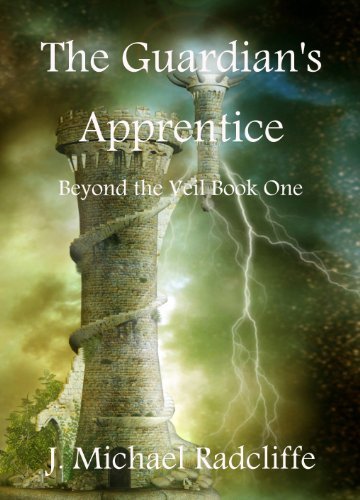Between the third and seventh centuries A.D., a religion called Manichaeism originated in the Middle East (Near East) and spread from the Roman Empire to China. Its belief system was based on a dual cosmology of light vs. dark: the spiritual world of light, which was good, and the material world of darkness, which was evil. It faded out around the fourteenth century, but the word “Manichaean” has remained in our vocabulary and is used in its connotative sense as a “dualistic contrast or conflict between opposites,” or in moral terms, a choice between good and evil.
As I began to read The Guardian’s Apprentice: Beyond the Veil – Book 1 by J. Michael Radcliffe, I thought this created world of magic could be a Manichaean setup. By the second chapter, I saw that it was not, although it could have shifted in that direction. Instead, Radcliffe has imagined a more complex world than one that perpetuates a dualistic battle between good and evil. The first book in the tetralogy Beyond the Veil, The Guardian’s Apprentice is based on a configuration of three sects of witches and wizards living on their side of the veil, many of them savoring a longevity unimaginable by those non-magic mortals on the other side. The beliefs of the sects about the nature of good and evil are built into their rules, regulations, and code of conduct, but even in spite of their differences, multi-layered as they are, the sects act as a barrier to The Shadow—their evil foe.
This magical world shares one planet with a non-magic world, and this planet is called Earth. “Separated by a tether of magic,” these two worlds live in their own realities, as if they are two planes or two intertwined circles inhabiting one space. Created by the Blackstar Amulet, the veil powers the action in The Guardian’s Apprentice, keeping the two sides from infiltrating each other; that is, the magical world retains its energy because the veil traps the magic inside their habitat and hides it (for the most part) from that of mortals on the other side—“non-magic outsiders.” If the veil didn’t exist, the two worlds would be as one.
The governing body of this magical world is the High Council, which was first convened one thousand years ago. Located in the capital Innenstadt, the High Council is comprised of three families represented by three different sects of wizards, the color of their stone indicating their particular order: the White, the Grey, and the Black. When the story opens, Phineas Whitestone heads the White Order, or the Order of Good; Alexander Ducat, the Grey Order, or the Order of Neutrality; and Cedric Thornback, the Black Order, or the Order of the Dark Arts—all permanent members of the Council. The three leaders plus nine elected members sit around an “enormous granite table shaped like a twelve-pointed star.”
Political infighting is not far from the surface among the members of this High Council, as the founders discovered long ago. To counter this unfortunate behavior the prescriptions include: First, the Oracle, a blue-white crystal that hovers above the surface of a pool in the center of the granite table radiates pure power, and when the debate turns violent, the orb captures the perpetrator, encasing him or her in crystal. Second, because of the differences and even hatred between the sects, they have maintained the long-standing neutrality of the Council Chamber “in the interest of the greater good of the magical world.”
When The Guardian’s Apprentice opens, political infighting is underway among the members of the High Council, and differences not only of opinion but also of power exacerbate the ideal of the White Order. With the mysterious death of Tobias Follett, “Chancellor of the High Council and head of the Grey order of Neutrality,” intrigue begins in the first pages of the “Prologue.” Phineas Whitestone, by a vote of seven to four, is voted in as the new Chancellor, a position he doesn’t want, and Cedric Thornback, who does, is passed over for the third time. The problem: Phineas is the Guardian and Keeper of the Blackstar Amulet, the talisman that “created the veil of separation and divided the magical world from the non-magical one.” Taking the seat of the Chancellor, Phineas is forced to relinquish his role as Guardian to either Ducat or Thornback, giving one or the other the power to appoint an apprentice guardian of their choice. To counteract this rule, Phineas sends his emissary to the other side of the veil to bring his grandson to him. Thus begins the journey of the mortal Keegan Whitestone, who has no idea that his lineage is none other than that of the powerful magician, Phineas Whitestone.
Keegan Whitestone, some thirty years old, is introduced to the magical side of the veil by Acamar Troelus Wycroft, an assistant to Phineas and in servitude to him. Appearing to Keegan for the first time as a black cat and then transmogrifying into a tall man with wire-rimmed glasses dressed in a black robe, Acamar befriends Keegan and summons him to appear in front of the High Council. Acamar’s appearance on the mortal side of the veil is of a piece with the strange ring Keegan wears on his finger “in the form of a coiled dragon” and a white stone inset that he received in the mail, along with the note, “Guard this with your life, as it will guide your destiny and determine your fate.” Leading a boring, unaccomplished, and mediocre life, Keegan is ripe for adventure. Following Acamar’s instructions, Keegan points his signet ring at a privet hedge and is magically transported through a portal to an unfamiliar habitat, Acamar at his side. Thus begins the trials and tribulations of the guardian apprentice who will soon discover that all is not what it seems.
Courage and insight are two significant lessons Keegan Whitestone learns during his apprenticeship, but he nearly loses his life on more than one occasion. In confronting malevolent forces like Brimstone, the dragon who betrays the High Council, or the Shadow, the embodiment of pure evil, that chases him, Keegan wills his mind to escape and thus finds courage. Likewise, in trusting beneficent powers like Kust, the wood elf who finds him on the edge of the Ebonwood forest, or Nekk’ar, the dragon coiled around his finger that lends the apprentice his superior consciousness, Keegan discovers the insight and purpose he lacked on the mortal side.
Keegan cannot successfully pass the three tests ordered by the High Council or confront the duplicity that materializes at every turn without the proficient use of the tricks of the magical arts: glyphs, staffs, wands, potions, poisons, hexes, defensive maneuvers, offensive attacks, disguises, transformations, transfigurations, transmogrifications, incantations, vortices, portals, gateways, scrying, amulets, talismans, and transportation charms. Employing this magic—sometimes as defensive maneuvers against his rivals, other times as offensive attacks to aid a companion threatened with death—he rises above his internal fear and ultimately seals the veil at Talith Nor that separates the two worlds of magic and mortal beings. No longer a mere apprentice after his grandfather’s death, he must now, as Guardian and Keeper of the Veil, uphold the moral authority of the White Order, as Phineas had instructed him: “You see, there are those who believe that the possession of immense power entitles one to rule over others. That in essence is the crux of our problem.”
The Guardian’s Apprentice: Beyond the Veil Book – 1 is a feast of intrigue that unfolds before our eyes, beginning in the “Prologue” and not stopping until the very last page. Wielding the literary technique of foreshadowing, Radcliffe accomplishes two missions at once: He maximizes the suspense and at the same time deepens the underpinning of this moral tale. The Guardian’s Apprentice is not only a thrilling fantasy, but it is also an allegory about the unquenchable drive for power—an all too familiar ambition that is cold comfort to our hearts and souls.



